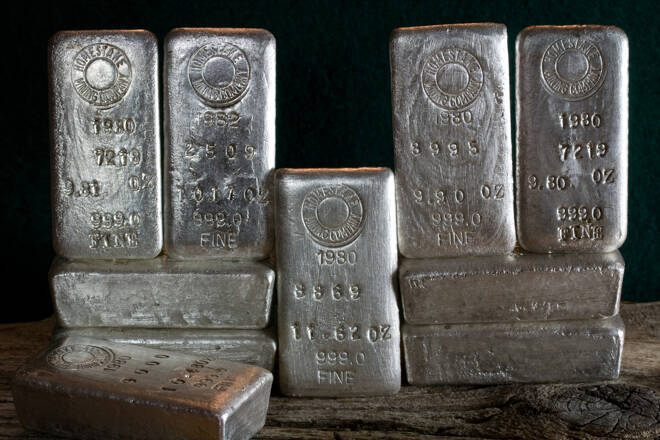Advertisement
Advertisement
Silver Price Prediction – Prices Fall on Dollar Strength
By:
Inflation data continues according to the latest PCE
Silver prices continued to fall after dropping more than 5.3% on Monday and Tuesday combined. The dollar continued to rally, putting downward pressure on silver prices. U.S. short-term treasury yields continued to rise as the markets focused on inflation. The Commerce Department released its inflation gauge along with stronger than expected GDP and consumption. The Labor Department reported strong jobless claims, which declined below the 200K mark for the first time since the pandemic started.
Regulated By:FCA, FSCM, CMA, SCA
Headquarters:Mauritius
Foundation Year:2011
Min Deposit:$200
Online Forex/CFDs are complex instruments and come with a high risk of losing money rapidly due to leverage. 81% of retail investor accounts lose money when trading Online Forex/CFDs with this provider. You should consider whether you understand how CFDs work and whether you can afford to take the high risk of losing your money. It is the responsibility of the Client to ascertain whether he/she is permitted to use the services of Exinity Capital East Africa Ltd based on the legal requirements in his/her country of residence.
Demo Account:Open Demo Account
Max Leverage:1:30 (FCA), 1:3000 (FSCM), 1:2000 (CMA)
Publicly Traded:No
Deposit Options:Wire Transfer, Credit Card, Skrill, Neteller, PerfectMoney, Local Transfer, FasaPay, , , , Debit Card,
Withdrawal Options:Wire Transfer, Credit Card, Skrill, Neteller, Debit Card, Local Transfer, FasaPay, , , PerfectMoney, ,
Products:Currencies, Commodities, Indices, Stocks, Crypto
Trading Platforms:MT4, MT5,
Trading Desk Type:No dealing desk
OS Compatability:Desktop platform (Windows), Desktop platform (Mac), Web platform
Mobile Trading Options:Android, iOS
Technical analysis
Silver prices continued to fally after breaking throught support near an upward sloping trend line that comes in near 23.97, which is now seen as resistance. Target support is seen near the November lows at 23.02. Medium-term momentum has turned negative as the MACD (moving average convergence divergence index) generated a crossover sell signal. This scenario occurs as the MACD line (the 12-day moving average minus the 26-day moving average) crosses below the MACD signal line (the 9-day moving average of the MACD line. Short-term momentum is also negative as the fast stochastic recently generated a crossover sell signal. Prices are oversold as the fast stochastic is printing a reading of 8, below the oversold trigger level of 20 which could foreshadow a correction.
Inflation Rises in Line with Expectations
Core personal consumption expenditures, which exclude food and energy increased 4.1% from a year ago, in line with expectations. The headline PCE index rose 5%, the fastest gain since November 1990. Consumer spending increased 1.3% during the month, higher than the 1% expected. That came with a 0.5% increase in personal income, well ahead of the 0.2% estimate. While consumer spending is rising, confidence is falling. The University of Michigan dropped to 63.5 for November, its worst in a decade and down from 67.9 in October.
About the Author
David Beckerauthor
David Becker focuses his attention on various consulting and portfolio management activities at Fortuity LLC, where he currently provides oversight for a multimillion-dollar portfolio consisting of commodities, debt, equities, real estate, and more.
Advertisement
